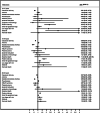The adverse maternal and perinatal outcomes of adolescent pregnancy: a cross sectional study in Hebei, China
- PMID: 32487101
- PMCID: PMC7268722
- DOI: 10.1186/s12884-020-03022-7
The adverse maternal and perinatal outcomes of adolescent pregnancy: a cross sectional study in Hebei, China
Abstract
Background: The adverse pregnancy outcomes caused by teenage pregnancy are major public health problems with significant social impact. While China is the most populous country in the world, and 8.5% of the women aged 10-50 years are adolescent women, we aimed to analyze the adverse maternal and perinatal outcomes of the adolescent pregnancy in Hebei Province, China.
Methods: There were 238,598 singleton pregnant women aged 10-34 years from January 1, 2013 to December 31, 2017 in the database of Hebei Province Maternal Near Miss Surveillance System (HBMNMSS). The 238,598 pregnant women were divided into two groups: adolescent group (aged 10-19 years) and adult group (aged 20-34 years). The adolescent group was divided into two subgroups (aged 10-17 years, aged 18-19 years), the adult group was divided into two subgroups (aged 20-24 years, aged 25-34 years). We compared the risk of adverse pregnancy outcomes using univariate and multivariate logistic regression. We also made a stratified analysis of nulliparous and multiparous adolescent pregnancy.
Results: Compared with women aged 20-34 years, women aged 10-19 years had lower risk of cesarean delivery [adjusted risk ratio (aRR): 0.75, 95% confidence interval (CI): 0.70-0.80], gestational diabetes mellitus (GDM) (aRR: 0.55, 95%CI: 0.41-0.73). Women aged 10-19 years had higher risk of preterm delivery (aRR: 1.76, 95%CI: 1.54-2.01), small for gestational age (SGA) (aRR: 1.19, 95%CI: 1.08-1.30), stillbirth (aRR: 2.58, 95%CI: 1.83-3.62), neonatal death (aRR: 2.63, 95%CI: 1.60-4.32). The adolescent women aged 10-17 years had significantly higher risk of stillbirth (aRR: 5.69, 95%CI: 3.36-9.65) and neonatal death (aRR: 7.57, 95%CI: 3.74-15.33) compared with the women aged 25-34 years. Younger adults (20-24 years) also had higher risks of preterm delivery (aRR: 1.26, 95%CI: 1.20-1.32), stillbirth (aRR: 1.45, 95%CI: 1.23-1.72), and neonatal death (aRR: 1.51, 95%CI: 1.21-1.90) compared with women aged 25-34 years. The structural equation model showed that preterm delivery and cesarean delivery had an indirect effect on neonatal death in adolescent pregnancy.
Conclusions: The adolescent pregnancy was related to adverse perinatal (fetal and neonatal) outcomes, such as preterm delivery, stillbirth and neonatal death, especially in younger adolescent pregnancies.
Keywords: Adolescent; Maternal outcomes; Perinatal outcomes; Pregnancy.
Conflict of interest statement
All authors declare that they have no competing interests.
Figures




Similar articles
-
Outcomes of Pregnancies for Women Undergoing Endoscopy While They Were Pregnant: A Nationwide Cohort Study.Gastroenterology. 2017 Feb;152(3):554-563.e9. doi: 10.1053/j.gastro.2016.10.016. Epub 2016 Oct 20. Gastroenterology. 2017. PMID: 27773807
-
Trends and adverse pregnancy outcomes associated with preeclampsia: a multi-centre cross-sectional study in Hebei, China.BMC Pregnancy Childbirth. 2025 May 3;25(1):528. doi: 10.1186/s12884-025-07609-w. BMC Pregnancy Childbirth. 2025. PMID: 40319233 Free PMC article.
-
Obstetric consequences of subfertility: a retrospective cohort study.BJOG. 2016 Jul;123(8):1320-8. doi: 10.1111/1471-0528.13584. Epub 2015 Sep 2. BJOG. 2016. PMID: 26335260
-
The intrapartum and perinatal risks of sleep-disordered breathing in pregnancy: a systematic review and metaanalysis.Am J Obstet Gynecol. 2018 Aug;219(2):147-161.e1. doi: 10.1016/j.ajog.2018.02.004. Epub 2018 Feb 15. Am J Obstet Gynecol. 2018. PMID: 29454869
-
Risk factors for adverse outcomes in twin pregnancies: a narrative review.J Matern Fetal Neonatal Med. 2023 Dec;36(2):2240467. doi: 10.1080/14767058.2023.2240467. J Matern Fetal Neonatal Med. 2023. PMID: 37518183 Review.
Cited by
-
The Prevalence and Risk Factors for Severe Maternal Morbidities: A Systematic Review and Meta-Analysis.Front Med (Lausanne). 2022 Mar 17;9:861028. doi: 10.3389/fmed.2022.861028. eCollection 2022. Front Med (Lausanne). 2022. PMID: 35372381 Free PMC article.
-
Trends of adverse pregnancy outcomes and its determinants in Arba Minch Zuria and Gacho Baba Woredas from 2018 to 2022: Analysis of health and demographic surveillance data.PLoS One. 2025 Jan 16;20(1):e0313564. doi: 10.1371/journal.pone.0313564. eCollection 2025. PLoS One. 2025. PMID: 39820610 Free PMC article.
-
Pregnancy among adolescent girls in humanitarian settings: a case in refugee camp of Gambella regional state, community-based cross-sectional study, Southwest Ethiopia, 2021.BMJ Open. 2022 Nov 17;12(11):e064732. doi: 10.1136/bmjopen-2022-064732. BMJ Open. 2022. PMID: 36396321 Free PMC article.
-
Adverse Perinatal Outcomes among Adolescent Pregnant Women Living with HIV: A Propensity-Score-Matched Study.Int J Environ Res Public Health. 2023 Apr 10;20(8):5447. doi: 10.3390/ijerph20085447. Int J Environ Res Public Health. 2023. PMID: 37107729 Free PMC article.
-
Associated factors of neonatal near miss among newborns of adolescent mothers in Brazil.Rev Esc Enferm USP. 2022 May 30;56:e20210359. doi: 10.1590/1980-220X-REEUSP-2021-0359en. eCollection 2022. Rev Esc Enferm USP. 2022. PMID: 35652629 Free PMC article.
References
MeSH terms
Grants and funding
LinkOut - more resources
Full Text Sources
Medical

